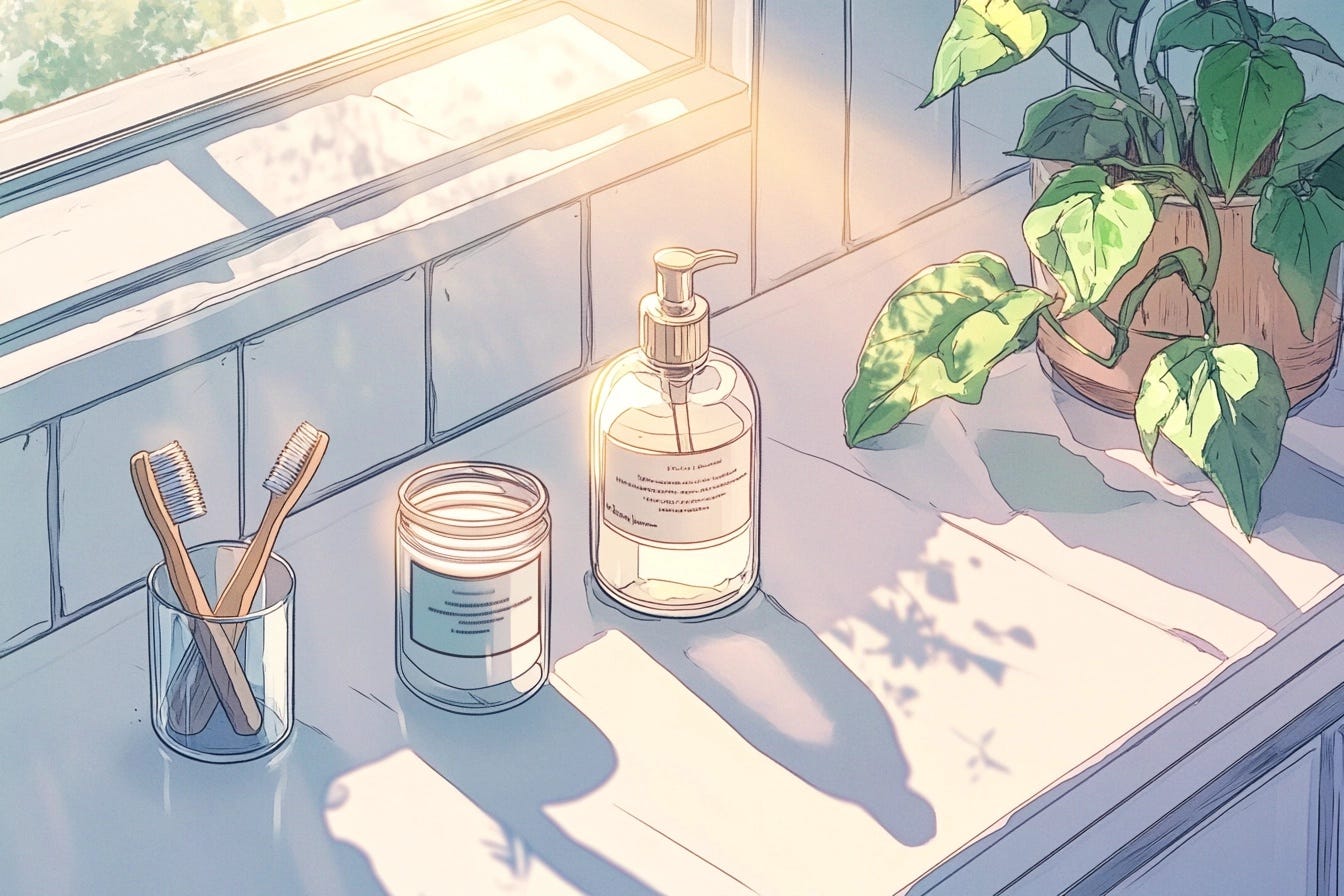Hidden Toxins in your Skincare and Easy, Healthier Swaps
What does your skin eat? Avoiding forever chemicals and endocrine disrupters may be simpler than you think.
We trust the products we use every day—on our skin, our teeth, our lips, and on our kids. But many of these personal care staples are silently burdening our bodies with synthetic chemicals that disrupt hormones, impact fertility, and increase toxic load. If you want to make a sustainable switch to healthier, low-toxin options, this is the post for you. Don't worry! You don’t have to overhaul everything overnight. Start small. Swap what you use the most. Here’s your simple guide.
Personal Care Items to Rethink
These are some of the most common culprits found in our daily routines.
Deodorant & Antiperspirant: Conventional options often contain aluminum salts (which block detox pathways like sweating) and fragrance blends linked to hormone disruption and skin irritation.
Toothpaste & Floss: Some flosses (especially “glide” types) are coated with PFAS, and many toothpastes contain synthetic preservatives, artificial flavors, or fluoride, which may be something you choose to avoid.
Lip Balm & Lipstick: What goes on your lips often ends up inside you. Many mainstream lip products contain lead, parabens, PFAS, or petroleum-based waxes, especially in long-wear formulas.
Body Wash & Lotion: Often full of fragrance, parabens, and artificial dyes that do nothing for your health—but everything to irritate your skin and burden your system.
Makeup: Foundation, mascara, and powders can contain PFAS for waterproofing or talc contaminated with asbestos. Fragrance and dyes are also common.
Period Products: Even “cotton” tampons can contain fragrance, pesticide residues, and plastic applicators—delivering toxins to the most absorbent areas of your body.
If you're curious about where to start, you can find a full searchable list of the products I choose for my own family at NontoxicGoods.com!
Ingredients to Avoid
Here's a list of toxins you can avoid with a close look at the label and packaging.
Fragrance / Parfum
A legal loophole. Manufacturers are not required to disclose the individual chemicals used to create their proprietary scents. This catch-all term can include phthalates, synthetic musks, and hundreds of harmful undisclosed chemicals. If you see “fragrance” or “parfum” and the brand doesn’t fully disclose what’s inside it, skip it.
Parabens
Look for anything ending in -paraben (e.g. methylparaben, propylparaben, butylparaben). These are common in moisturizers, lotions, and makeup as preservatives and have estrogenic effects.
Phthalates
Rarely listed by name. Instead, they often hide in:
Fragrance/parfum (they help scent stick to skin)
Plastic packaging or applicators
Flexible plastics (like squeezable tubes)
Vinyl labels or coatings on packaging
Tip: Avoid “long-lasting” fragrance or flexible plastic packaging when possible.
PFAS (Per- and Polyfluoroalkyl Substances)
Almost never named directly. Be cautious of:
Waterproof or long-wear makeup (mascara, foundation, lipstick)
Non-stick or "smooth glide" claims on floss and applicators
"Stain-resistant" or "moisture-wicking" fabrics in packaging, wipes, or pads
Tip: If it boasts water resistance, grease-proofing, or long wear, it may contain PFAS—even if not disclosed.
Aluminum Salts
Look for ingredients like aluminum chlorohydrate, aluminum zirconium tetrachlorohydrex gly, etc.—most often found in antiperspirants.
Artificial Dyes
Typically labeled as:
FD&C or D&C followed by a color and number (e.g. FD&C Red 40)
These are common in shampoos, lotions, lipsticks, and kids’ products.
Tip: Brightly colored products are usually artificially dyed.
BPA & Plastics
These won’t be on a product label—but look out for:
Plastic containers with recycling codes #3 or #7
Glossy coatings (especially thermal receipt paper, toothbrush handles, applicators, floss picks)
Scented or colored tampons and pads (may have plastic coatings or BPA-laced components)
Tip: Choose glass, stainless steel, bamboo, or paper packaging when possible.
Did you know? The skin is not just a barrier—it’s a sponge. If you wouldn’t eat it, think twice before putting it on your body.
Low-Toxin Swaps to Start With
For a full, searchable list of the non-toxic products my family uses, check out NontoxicGoods.com! I only recommend the products that we use and love–and I keep this list updated each time I find a new swap.
Natural deodorant instead of antiperspirant: Look for solid sticks with essential oils or gentle formulas free from baking soda and fragrance blends. For a ridiculously simple deodorant option, try a "salt stick" crystal deodorant.
Floss: Use plant waxed silk or charcoal floss without PFAS coatings. My favorites are these BPA, PFAS, and PTFE-free floss picks.
Toothpaste: Try one made with non-nano hydroxyapatite (a fluoride alternative) and no artificial flavors, like this USA-made prebiotic mineral toothpaste.
Lip Care: Choose organic balms or lipsticks, and avoid “longwear” products. For a super simple and healthy lip balm, try a DIY tallow balm recipe!
Skincare: Look for unscented or essential oil–scented versions based on tallow, shea or cacao butter, or other nourishing whole ingredients that you'd also find in your kitchen pantry. My favorite supplier is Bello Tallow—most of their products are tested for PFAS.
Makeup: Start with brands that test for heavy metals and list every ingredient. EWG Verified brands like this one are a good place to start. Avoid “waterproof” or “24-hour wear” products which can include PFAS.
Period Products: Opt for organic cotton pads or organic cotton tampons without applicators, or try reusable options like medical-grade silicone cups or washable cotton pads.
A Note on Mindset: Grace Over Guilt
Rather than a race, lowering your family's toxic load is an ongoing journey of discovery. You don’t need to do everything at once. Focus first on what you use daily, like your deodorant, toothpaste, and lip balm. Start there. Replace products with healthier swaps when you run out.
Every small change you make contributes to a larger impact. By choosing safer alternatives, you're protecting your health and also supporting brands that prioritize transparency.
Here’s How to Maintain Your Progress:
Create a "Clean Catalog": As you discover new products and make healthier swaps that work better for your family, consider keeping a list or a capsule collection of your favorite new finds! This will help save time when you do the shopping and keep your choices conscious and intentional.
Share With Your Community: Share your journey with friends and family. Start conversations about toxic ingredients and encourage others to join you in exploring healthier options.
Celebrate Small Wins: Acknowledge your efforts! Every product swap is a step towards reducing your toxic load and enhancing your health. Celebrate these victories, no matter how small.
Remember that change doesn't have to happen overnight. It’s perfectly okay to take your time, research better products, and find what works best for you and your family. You can build a healthier future one thoughtful choice at a time!
Like this post?
Come hang out and get more simple swaps for reducing toxins in your home!
If you choose to make a purchase through some of the links on this page, I may receive a small thank-you commission as an Amazon affiliate—at no cost to you! Thank you for your support!




